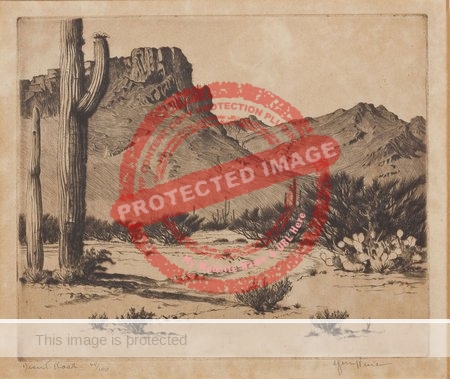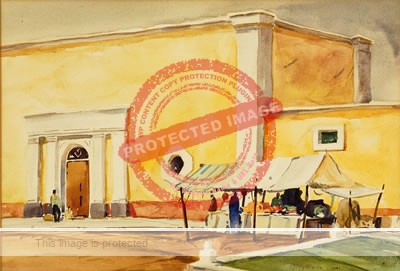Watercolorist, etcher and illustrator Elbridge Gerry Peirce Jr., more usually known simply as Gerry Peirce, was born in Jamestown, New York on 3 June 1900 and died in Tucson, Arizona, on 16 March 1969.
Peirce visited Ajijic in the mid-1940s, and may have been there more than once since he is known to have made several trips to Mexico. His visit to Ajijic, believed to be in 1945, was recorded by American author Neill James who had settled in the village a year or two previously: “Gary Pierce [sic], director of an art school in New Mexico, visited our village and executed many delicate water colors and engravings.” (Modern Mexico, October 1945). Despite the misspelling, and the fact that the art school that he directed was actually in Arizona, there is absolutely no doubt that James was writing about Gerry Peirce. Sadly, the whereabouts of his paintings and engravings of Ajijic remain a mystery.
Peirce graduated from the Cleveland School of Art (now the Cleveland Institute of Art) in 1925, and also studied at the Art Students League in New York City. He married his childhood sweetheart, Priscilla, and the couple moved to Nova Scotia, Canada, where Peirce began to execute etchings and engravings.

Gerry Peirce. Desert Rock. Undated.
After Canada, Peirce and his wife lived and worked in New Orleans. His time in New Orleans is particularly noteworthy because he was one of the co-organizers and charter members of the New Orleans Art League in December 1929. The other organizers were Harry Armstrong Nolan (1891-1929), Gideon Townsend Stanton (1885-1964), William Weeks Hall (1895-1958) and Henry Costello. By coincidence, Gideon Townsend Stanton also had close family links to Chapala: his maternal grandparents had a holiday home there for several years at the very end of the nineteenth century.
This early dry point, The Cat, is one of several dry points gifted by Peirce to the Cleveland Museum of Art in 1934:

Gerry Peirce. The Cat. 1932. Credit: Cleveland Museum of Art.
In the early 1930s, during the Great Depression, Peirce and his wife lived in various places, including Florida, Cuba, New Mexico, Washington D.C., New York City and Philadelphia, where Peirce established a commercial art studio, producing cards for Cartier and Tiffany & Co.
In 1932, a group of Peirce’s etchings, some done in Frijoles Canyon near Taos, were included in a group show at the Santa Fe Art Museum.
[Shortly afterwards, the museum exhibited a collection of pottery from Tonala and San Pedro Tlaquepaque, organized by Mrs Heather Campbell Holms, the wife of the British vice-consul in Guadalajara. The Holms’ had a workshop for local potters, and this exhibit included “dish gardens” of miniature peons, donkeys, chickens, cacti and what not, accompanied by paintings by Mrs Holms showing how the figures are placed.”]
Later, the Peirces moved to Colorado and began to spend winters in Arizona, eventually making their home in Tucson, Arizona, in the mid-1930s. Peirce opened an atelier (“The Print Room”) in Tucson in 1934 and continued to produce wonderful dry point engravings. He also turned his hand to books.
Writing as “Percival Stutters”, Peirce wrote and illustrated at least two children’s books: How Percival Caught the Tiger (1936) and How Percival Caught the Python (1937), both published by Holiday House. Peirce also drew the black and white illustrations for Plants of Sun and Sand: The Desert Growth of Arizona, which had short texts by Stanford Stevens and was published by The Print Room, Tucson, in 1939. The original edition of that particular book is highly distinctive since it had a plywood cover.

Gerry Peirce. Untitled watercolor. Unknown date.
At about this time, a sketching trip with Stevens turned out to have a momentous impact on Peirce’s subsequent art career. As Peirce later recalled:
One day I was looking at a scene Stan was doing and wondered why he had picked out that particular spot. Why paint that I asked? His reply, “Because it has such a beautiful color,” jolted me right out of everything I’d been doing for the past twelve years. I realized that I was no longer seeing a landscape with its colors, but in terms of the black and white of etchings. I saw that even my etchings were becoming flat no longer suggesting the color of things.”
Though he never stopped producing his exquisite engravings, after Peirce picked up a brush and watercolors, he never looked back. He soon gained recognition as one of the country’s leading watercolorists. He was also a fine teacher and his studio-classroom attracted students from all across the country. In 1947, the Tucson Watercolor Guild was organized to provide a permanent studio and classroom space for Peirce to continue his work. His teaching career was curtailed by a heart attach in 1967.
In later life, Peirce wrote two non-fiction works: Creative You (The Print Room, 1954) and Painting the southwest landscape in watercolor (Reinhold Pub. Corp., 1961).
Peirce’s timeless portrayals of the Arizona desert and his tireless efforts to help others see the beauty he saw helped shape Tucson into the artistic center of Arizona.
- History Moment: Gerry Peirce (story by Tony Paniagua) is a professionally-produced 5-minute video summarizing Peirce’s career and art.
From Arizona, Peirce made several sorties into Mexico. The wonderful collection of prints, published by The Print Room in 1969 as The drawings of Mexico, included images of San Miguel de Allende; Marfil and La Valenciana (both in Guanajuato); and of Tzintzuntzan (Michoacán). By this time, Peirce was no longer completing watercolors en plein air but was making quick pencil sketches or rapid watercolor impressions in the field to serve as memory aids for his final paintings done back in the studio.
A contemporary reviewer described the collection as “a portfolio of reproductions of pencil drawings made by Gerry Peirce in Mexico, a country he visits frequently and understands. This understanding and his affection for the country and its people are reflected in every sensitive line and shading of these outstanding drawings.”

Gerry Peirce. Nogales hillside. Undated.
Peirce was a frequent exhibitor wherever he lived and a member of the Society of American Etchers, the Chicago Society of Etchers, and the California Print Makers. Note that the oft-repeated claim in contemporary newspaper accounts that Peirce had been awarded an honorary doctorate in art by “St. Andrews University College in London” can not be substantiated since there is no record of any institution of that name, though it is possible that Peirce was granted an honorary degree by St. Andrew’s University in Scotland.
Peirce’s work is in numerous museums including The Metropolitan Museum of Art; Harvard’s Fogg Museum; the Boston Museum of Fine Art; the Library of Congress; Joslyn Museum, Omaha, Nebraska; the J.P. Speed Memorial Museum (now Speed Art Museum) in Louisville, Kentucky; Denver Art Museum; Arizona Museum of Art; Tucson Museum of Art; the Mobile Museum of Art; Cleveland Museum of Art; University of Arizona Art Museum; and the New Mexico Museum of Art.
In 1980, more than a decade after Peirce’s death, a retrospective exhibition of his watercolors and etchings was held at the Kay Bonfoey Studio and Gallery in Tucson. Bonfoey, one of his former students, had purchased the adobe-and-redwood building that had formerly been Peirce’s studio and classroom space after his death to run her own gallery, and to continue the legacy of the Tucson Watercolor Guild. Interviewed at the time, Bonfoey said that Peirce was:
… a unique human being. He wasn’t just a teacher of art, he was a philosopher, a thinker. No two classes were ever the same, the explorations were always different, always … well, awesome. He constantly looked into the relationship between nature and art. Nature was the base for everything he saw in his paintings, in other people’s work, in life around him.”
A fitting tribute to one of America’s great twentieth-century watercolorists.
Sources:
- Arizona Highways Magazine. 1945. “Gerry Peirce”. Volume 21, 1945.
- Art Life magazine. “Biography of Gerry Peirce”. Art Life magazine.
- Arnold Elliott. 1951. Tucson Festival of the Arts, Exhibition Catalogue, March 25-April 8, 1951.
- Judith H. Bonner. 2011. “New Orleans Art League.” Article dated 23 May 2011 in Encyclopedia of Louisiana, edited by David Johnson. (Louisiana Endowment for the Humanities).
- Peter H. Falk (ed). 1985. Who was who in American art, 1564-1975.
- Neill James. 1945. “I live in Ajijic”, in Modern Mexico, October 1945.
- John Peck. 1980. “Late artist Peirce comes home.” Arizona Daily Star (Tucson), 11 May 1980, p 75.
- Peggy and Harold Samuels. 1985. Encyclopedia of Artists of The American West. Castle Books.
- The Santa Fe New Mexican: 2 July 1932, 4.
- Tucson Daily Citizen (Tucson, Arizona). 15 October 1960, p 12; 1 September 1965, p 15; 13 August 1966, p 29; 17 March 1969, p 22 (obituary).
- Warren Times Mirror (Warren, Pennsylvania), 11 December 1934, p 5; 11 March 1939, p 2; 1 August 1939, p 8; 16 March 1949, p 4.
Sombrero Books welcomes comments, corrections or additional material related to any of the writers and artists featured in our series of mini-bios. Please use the comments feature at the bottom of individual posts, or email us.
Tony Burton’s books include “Lake Chapala: A Postcard History” (2022), “Foreign Footprints in Ajijic” (2022), “If Walls Could Talk: Chapala’s historic buildings and their former occupants” (2020), (available in translation as “Si Las Paredes Hablaran”), “Mexican Kaleidoscope” (2016), and “Lake Chapala Through the Ages” (2008).